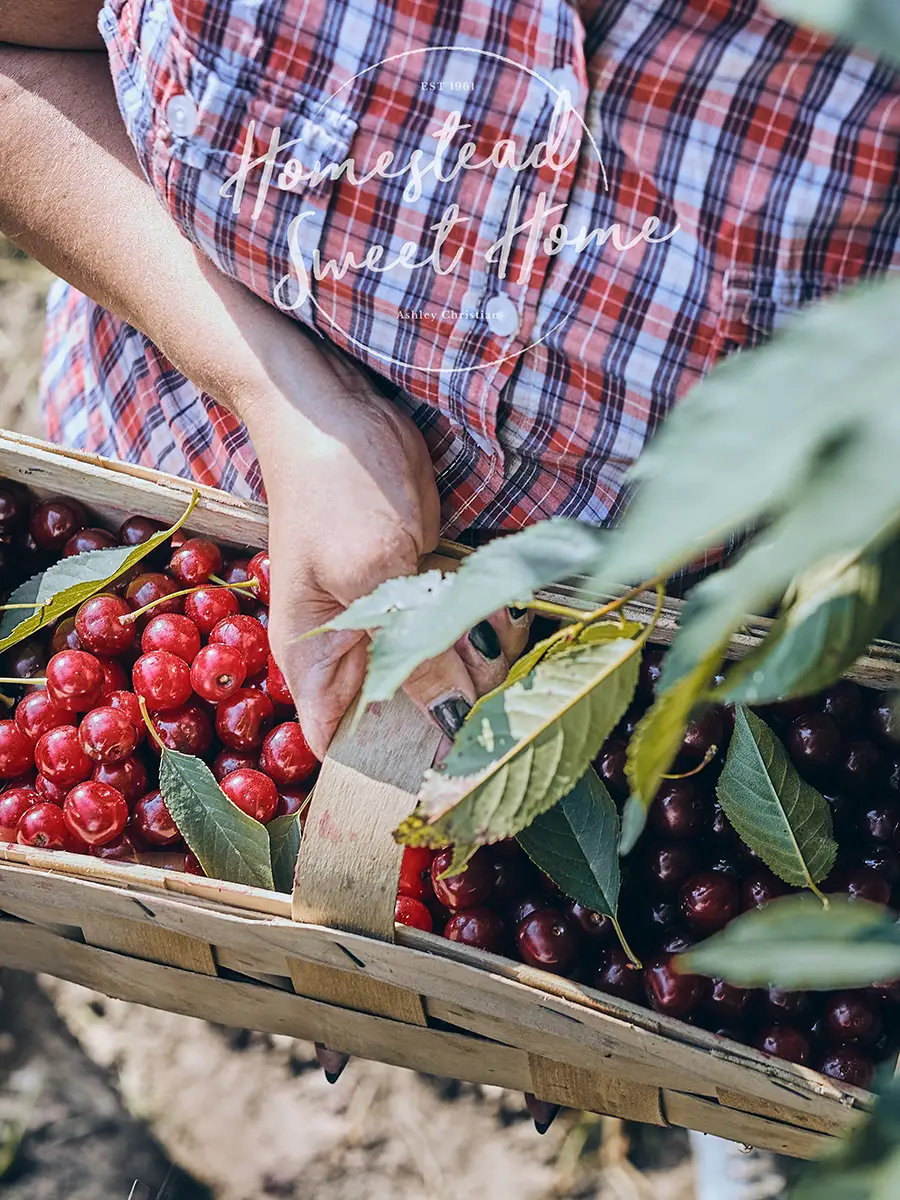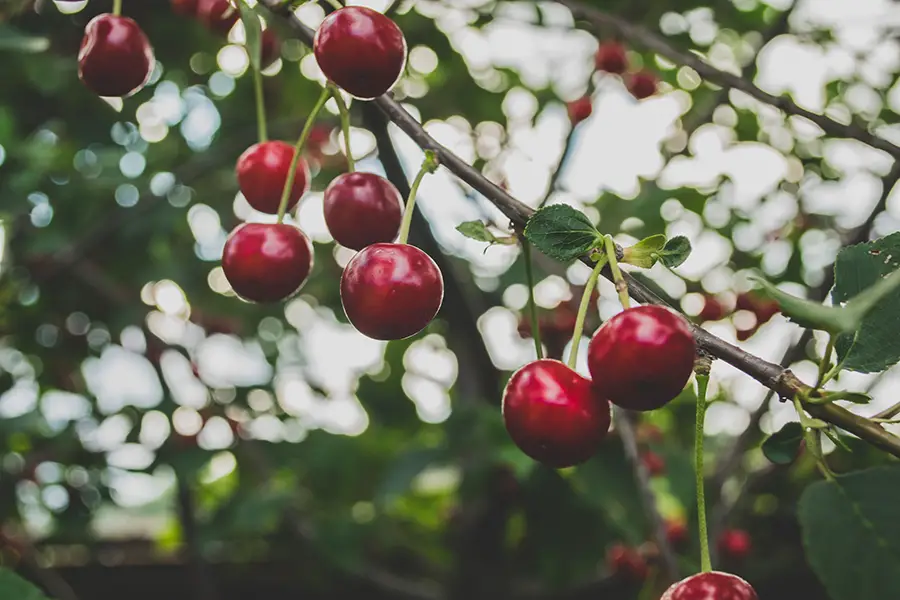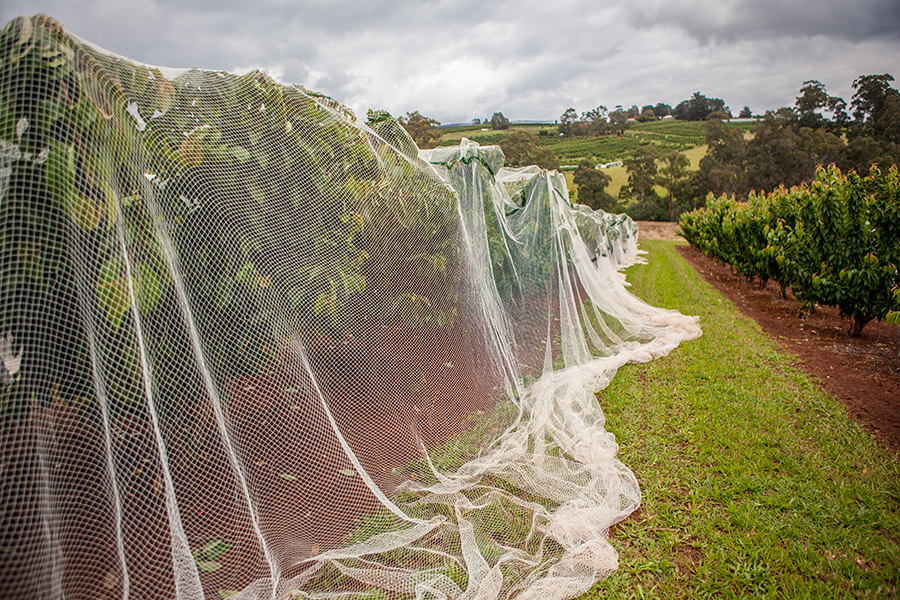Cherry Tree – How to Choose the Right One for Your Zone

Sweet cherry trees grow best in zones 5 through 7, while sour cherries grow best in zones 4 through 6. Some hybrid varieties can grow well in zones 6 through 9. Cherry trees need to be planted in full sun in well-draining soil. Sour cherry trees do not need other cherry trees to cross-pollinate, but sweet cherry trees will need other sweet cherry varieties to pollinate. Cherry trees begin to produce fruit 4 to 7 years after planting.
There are many wonderful reasons to grow cherry trees, from making family memories, harvesting your own delicious fruit, to enjoying the beautiful spring blooms. I still remember growing up as a 5th generation homesteader in California and climbing through the cherry tree fields with the neighbor kids picking and eating as much as we could. The smell of the blooms, bare feet up in trees, and the rich taste of the fruit is something I will never forget.
Though growing cherry trees can become something of a challenge, with a few special tips and today’s modern disease-resistant varieties, successfully growing cherry trees can be a reality for most home gardeners.
Sweet Cherry Trees (Prunus avium)
Fruit from sweet cherry trees is what you would typically find in the supermarket. But what you can grow and harvest from your own trees will outmatch any cherry you’ve ever tasted. Sweet cherries have a meaty texture with a sweet, rich flavor and are typically eaten as is by snacking on them fresh, using them in savory dishes, or even freezing or drying them for later use.
Sweet cherry trees need a certain amount of cold weather, called chilling hours, to produce fruit. Therefore most sweet cherry trees do best in zones 5 through 7. 97% of America’s sweet cherry produce is grown in the moderate and dry climates of the west coast. In Califonia, Oregon, and Washington, it gets cold enough for the sweet cherries to bloom in the spring while staying dry to their liking and not scorching hot for long periods in the summer.
Though most nurseries will rate their sweet cherry trees for zones 5 through 8, those in zone 8 many have trouble getting their cherry trees to produce fruit if it isn’t cold enough. Sweet cherry trees need about 2 months of temperatures below 45 F in order to produce fruit. You can research your zone’s annual weather patterns and decide if a sweet cherry tree is right for you.
If you are in zones 8 or 9, you can look for a hybrid sweet cherry tree that needs fewer cold days to produce fruit such as the sweet Lapins or the sour North Star.
Sweet cherry trees are not self-pollinators, so they need to be planted with other sweet cherry trees to pollinate. Pay attention to bloom time and do your best to plant with other sweet cherry trees of a similar bloom time.

Sour Cherry Trees (Prunus cerasus)
With the exception of hybrid varieties, sour cherry trees grow best with a strong winter chill, in zones 4 to 6. The majority of sour cherry produce is grown in Michigan where they do very well. Sour cherries are most often used for canning and baking in pies because their tartness pairs well with the added sweetener.
Sour cherry trees are a little quicker than sweet cherries to start producing fruit, usually between years 3 through 5. If you get a dwarf variety, though they will produce less fruit, they usually start producing sooner. Sour cherry trees are also less finicky and easier to grow compared with sweet cherries.
Can I Grow a Cherry Tree in My Backyard?
Yes, you can absolutely grow cherry trees in your backyard! Do remember that cherry trees need full sun and well-draining soil. If your soil isn’t well-draining, your cherry tree will be susceptible to root rot, so you’ll need to do some work on your soil. You can amend and till the soil with sand and compost to help create a nice loomy soil that drains well. You can also grow dwarf cherry trees in a container or a large pot.
When choosing a location for your cherry tree, you’ll want a place that gets full sun for 8 hours a day. Watch out for areas of partial shade created by fences, your home, and other trees. If you have good soil and sun for your cherry tree, the next thing you need to consider is the type of tree you’re growing.
Is your family more likely to eat sweet cherries as a snack, or do they prefer sour cherries frozen and mixed in smoothies or canned and baked in pies? Consider which variety your family will enjoy the most and plant that one.
You will also need to consider your zone and pick an appropriate variety for your local weather conditions. Sour cherries like it cold, and sweet cherries like it moderate and dry. Hybrid varieties are worth considering if you are not in zones 4 through 7 and live somewhere with high humidity.
Another important consideration is if you’ll need to plant multiple cherry trees to cross-pollinate with each other, or if one self-pollinator will do. It all depends on your variety. Usually, sweet cherry trees need a friend, and sour or hybrid will do fine on their own. This isn’t true 100% of the time though, so be sure to read the instructions for your specific variety of cherry tree.
When planting a cherry tree in your backyard, you’ll also want to look at its full-grown size and plant it accordingly. You’ll need enough space between trees so they can each grow a healthy root system over the next 10 years until they are fully grown. Standard cherry trees that grow large should be planted 35 to 40 feet apart. Smaller dwarf trees you can plant 8 to 10 feet apart.
How Do You Take Care of Cherry Trees?
Start Right
Proper care of cherry trees starts with selecting the right spot in full sun and at the correct distance from other trees. You’ll also need to make sure you have the correct soil that drains well and the right variety for your region and weather. If you can get these three steps right as discussed above, you have done most of the work in setting your cherry tree up for health and success.
Watering
Once you’ve properly planted the right tree in the right spot, you can begin caring for it by keeping it consistently watered for the first year. Water your tree as you would with a vegetable garden. It’s best to water deeply, then allow the soil to dry up some, then water deeply again a week later. If you’ve had more than an inch of rain in a week, you can skip watering that week. Using mulch around the base of the tree will go a long way to stop moisture from evaporating.
Fertilizing
To feed and fertilize your tree observe it for signs of health. If it looks healthy, simply adding compost in the spring will be enough. If your tree doesn’t seem healthy or is not growing as quickly as it should, you may need to add fertilizer. Instead of playing a guessing game, it’s best to do a soil test and add the nutrients that are missing according to the fertilizer directions.
Pruning
Pruning cherry trees is a very important part of their health, growth, and productivity. Pruning ensures the canopy of your tree is strong and not weighed down, and is open to let in light. The problem with giving blanket pruning advice is that the timing depends on your variety and your climate. Like much of the advice in the homesteading world, the answer can change depending on where you live. Your best bet is to ask your local nursery about pruning or email your local county extension office which specializes in agriculture in your area and are normally quite happy to help. If you ask five gardeners how to prune a cherry tree, you’ll get six different answers. This is your cue to not overthink the pruning. Use the advice of people local to you and then just prune. It’s easier than you think.
Bird Deterrents
One final thought on caring for your cherry trees. Once they begin to fruit, you will likely need to protect them from birds who will think you planted your trees for them. You can test out tying reflective streamers or pie pans onto your trees to scare away birds. If that doesn’t work you will need to put bird netting over the top of your tree during the summer.
Common Question About Cherry Trees
Do I Need Two Cherry Trees to Get Fruit?
If you are planting sour cherry trees, they are self-pollinating so you only need one to pollinate itself. Keep in mind sour cherry trees do best in zones 4 to 6. If you are planting sweet cherry trees, they are not self-pollinating so you will need at least one more sweet cherry variety that blooms around the same time. Hybrid trees are usually self-pollinating so you will only need one.
How Fast Do Cherry Trees Grow?
If you’ve followed all the instructions above in choosing and caring for your cherry tree, you can expect sweet cherries to grow 10 to 15 inches per year. Sour cherries grow at about 8 to 10 inches per year. You may find they grow even during years with a lot of rainfall.
Are Cherry Trees Easy to Grow?
Hybrid cherry trees are easier to grow than heirloom varieties. Heirloom varieties are more susceptible to root rot, disease, and drought. That being said, if you choose the right tree for your area and the right location and soil, growing a cherry tree is something even a beginner gardener can do. The hardest part about growing a cherry tree is waiting years for it to begin producing fruit.
How Big Does a Cherry Tree Grow?
A standard sweet cherry tree can grow up to 35 feet tall and 25 feet wide. These beautiful trees make a lovely orchard, the kind I remember playing in as a child. Dwarf sweet cherry trees grow an average of 15 feet tall. Sour cherry trees average about 20 feet tall, while dwarf varieties will grow to between 8 to 10 feet tall. The wild black cherry tree of North America can grow up to 80 feet tall.
Ornamental cherry trees like the Amanogawa grow to about 25 feet tall, while the Japanese Yoshino grows to about 45 feet tall. Even if you don’t grow ornamental cherry trees for their fruit, they would make a stunning addition to any landscape and can be planted in zones 5 through 8.

What Season Do Cherries Grow?
Depending on your climate, cherry trees will blossom in the spring, and be ready for fruit harvest in the summer.
How Long Does a Cherry Tree Live?
Cherry trees typically live between 15 to 30 years. However, they can live much longer. The wild black cherry tree has been known to live up to 250 years.
Can Cherry Trees Grow in Pots?
Yes, cherry trees can be grown in pots. Selecting a dwarf tree will be a good fit for a pot. You’ll want to make sure your pot is big enough as well, so look for a pot 15 gallons or larger. Lastly, make sure your pot has plenty of drainage holes in the bottom to prevent root rot in your cherry tree.
Do Cherry Trees Produce Cherries Every Year?
After the first 5 to 7 seasons, as long as your tree is healthy, it should produce cherries every year. If for some reason your tree is not producing cherries every year, that’s a sign it’s not healthy. Go back to the basics of how to care for a cherry tree and make sure you’re not missing anything.
Are Cherry Trees Messy?
In general, cherry trees are not messy. Ornamental trees will not have fruit at all, and fruiting trees should only drop minimal cherries on the ground. If you’re concerned about a mess, make sure to protect your tree from birds, and harvest your cherries regularly.
Can I Grow a Cherry Tree in the House?
Yes, you can grow a cherry tree in the house, with some modifications. You’ll need to choose a dwarf variety and keep it in a well-draining pot. Your tree will also need 8 hours of full sunlight each day. So unless you have a sunroom, you’ll need to use grow lights. Keep in mind your cherry tree will also need a minimum of 2 months in below 45 degrees F weather, so you’ll need to move your tree outside in the winter. When we think about it, it makes a lot more sense to keep your cherry tree outside if possible.
How Do I Keep My Cherry Tree Small?
If you are looking for a small cherry tree, you’re best off choosing a dwarf variety when you first buy it, this is the best way to keep it small. Good pruning practices will also ensure that your tree grows into a nice shape with a good even canopy.
Which Cherry Tree is Best?
As we discussed before, this really depends on your climate. The best tree is the one that fits your climate and your space. This will be a different answer for everyone. That being said, you may look into hybrid varieties that are more disease, drought, rot-resistant, and easier to grow. Gisela, Krymsk, or Colt are all good hybrid choices.
When Should I Buy a Cherry Tree?
Cherry trees are best purchased and planted in the spring or fall when the ground is naturally moister and the temperatures moderate. After planting cover the base of the tree with mulch and water well, about once a week for the first year.
What about you, have you planted a cherry tree before, or are you considering growing one? Let us know your experience in the comments below.


Leave a Reply